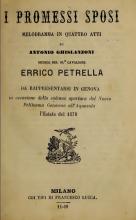Alessandro Manzoni's I Promessi Sposi represents a watershed moment in the making of modern Italy. Held up as the one of the foundational texts of modern Italian, I Promessi Sposi is perhaps one of the most studied and taught works of Italian literature after Dante. Being so ingrained in the cultural and artistic identity of Italy, it is no surprise that this text would be adapted for the operatic stage. There are no fewer than three interpretations of the opera represented in the Fisher Library's holdings, with compositions by Ponchielli, Petrella, and Traventi, with other containing interludes based on the novel. 
Manzoni's influence was such that upon his death in 1873, a requiem was composed by Giusseppe Verdi to celebrate the author. Verdi originally tried to coordinate the composition of a requiem mass in 1868 to commemorate the passing of another Italian luminary, Gioachinno Rossini. This original requiem would be the product of many different Italian composers, each charged with composing a section of the mass. The composition as originally imagined was never completed, but upon the death of Manzoni, Verdi resolved to complete the piece for the anniversary of the author's passing, now composing the entire work himself.
 Verdi's Requiem and the context of its composition tell us something about Italian history in the late 19th century. Emerging from a turbulent unification and a long history of cultural plurality, the music would reflect Italy's changing identity as a country, with one of its best-loved composers marking the death of the one of its most prominent authors. Engaging with the then in-vogue drive to memorialize, the "idea" of Italy needed to be established through the creation of shared memories that could unify the new country and its people across cultural and geographic boundaries. At this time, new interest in Italy's artistic and literary legacy emerged, and in the words of Laura Basini (citing Tobia), "knowledge of figures such as Dante and Petrarch in literature, or Guido d’Arezzo and Palestrina in music, was transmitted from scholars to the populace via a plethora of means: from ‘history books read by only a few . . . [to] commemorations, anniversaries, centenary or semicentenary celebrations . . . iconography, busts in gardens . . . monuments, urban toponymy . . . [and] patriotic pilgrimages.'"
Verdi's Requiem and the context of its composition tell us something about Italian history in the late 19th century. Emerging from a turbulent unification and a long history of cultural plurality, the music would reflect Italy's changing identity as a country, with one of its best-loved composers marking the death of the one of its most prominent authors. Engaging with the then in-vogue drive to memorialize, the "idea" of Italy needed to be established through the creation of shared memories that could unify the new country and its people across cultural and geographic boundaries. At this time, new interest in Italy's artistic and literary legacy emerged, and in the words of Laura Basini (citing Tobia), "knowledge of figures such as Dante and Petrarch in literature, or Guido d’Arezzo and Palestrina in music, was transmitted from scholars to the populace via a plethora of means: from ‘history books read by only a few . . . [to] commemorations, anniversaries, centenary or semicentenary celebrations . . . iconography, busts in gardens . . . monuments, urban toponymy . . . [and] patriotic pilgrimages.'"
The turn towards historicization and commemoration reflect the tenuous political identity of the former collection of city-states. While Dante, Petrarch, and Palestrina spoke to an ancient cultural heritage, Manzoni and Verdi were modern Italians of the Risorgimento: individuals who partook in and laid claim to a place in Italy's artistic tradition and on whom the populace would pin their aspirations for an emerging nation.
The Thomas Fisher Rare Book Library is grateful for the funding support of The McLean Foundation which enabled the digitization of our Italian Libretti Collection.
URLS:
Traventi Libretto: https://archive.org/details/ipromessisposime00trav
Petrella Libretto: https://archive.org/details/ipromessisposime00petr_1
Ponchielli Libretto: https://archive.org/details/ipromessisposime00ponc_1
Verdi Libretto: https://archive.org/details/messadarequiemte00verd



